Dude! Take Your Turn!
A Gaming Life
Boardgame Geek Top 300 – Play or Played – #300-291
Wow, I’m lazy.
Either that, or I’ve been in a bad mental space. You know, 2021 was supposed to be better, but so far it’s barely been marginally better and that’s only because 2020 sucked so much.
I finished the Top 200 BGG games on January 6 and here we are in mid-February and I’m finally getting to the Top 300!
I even downloaded the list in January but had to download a new version because it was so old.
But I finally made it. Even if two of them aren’t actually not in the Top 300 any more (yes, we have a new addition at #292 right now, with Garphill Games’ Viscounts of the West Kingdom, so congratulations Shem! Along with this is the latest hotness, Lost Ruins of Arnak hitting #293)
I’m proud of myself.
Of course, that could be because of the new confidence instilled in me by my new cult leader.

Yeah, the drugs are good…
So anyway, let’s get started with the Top 300 games on Boardgame Geek!
This is based on the list downloaded as of February 8, 2021.
Let’s get this show on the road!
#300 – Blood Bowl: Team Manager (Fantasy Flight Games) – 2011

Designer: Jason Little
Artists: a bunch!
This is now at #302 (sad face)
Blood Bowl: Team Manager was one of the first games I bought when I first got into gaming. It came out in 2011 and I first joined in 2012, but I had fond memories of playing Blood Bowl when I was in high school, 25 years before.
Since Ascension was one of my first games when I returned, it was only fitting that I jumped onto a sort of deck-builder (in a way, but nothing like Ascension) as one of my first games.

Blood Bowl: Team Manager takes the old Blood Bowl game and abstracts it into a season of games, with players forming their own team and assigning them to either tournaments or other scrimmages during the week.
There are a variety of teams available for players. The base game has Humans, Dwarves, Elves, Orcs, and a few others as well.
You’re not getting a whole Blood Bowl experience, but you do get a sense of it as players work through their decks, acquire Star Players (who are much better players than the default ones that are in your deck) and other abilities that you can play during the next season.
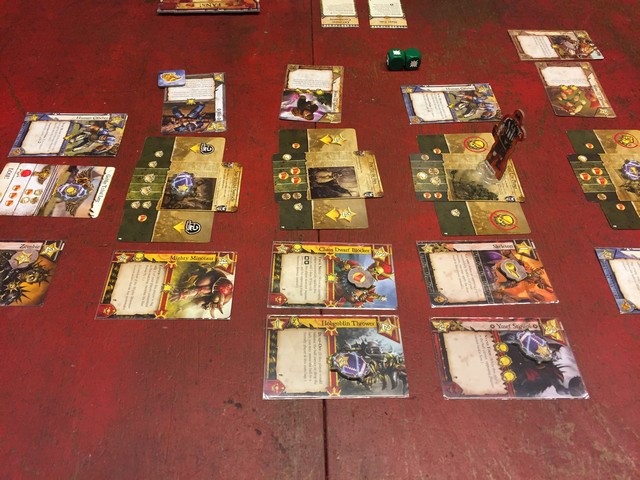
It’s not Blood Bowl, and players shouldn’t think it is. But it’s a great card game that gives you the feeling of playing a full season of Blood Bowl goodness while sticking to the card game mechanic.
I love this game so much that it was in my Top 25. I think it still is, even though I haven’t played it in a year or so.
The game really comes into its own with the expansions, though I don’t really care that much for the “corrupt referee” mechanic. But the extra teams in the expansions, plus the stadiums (as long as you randomize them rather than playing the “rules as written” where they are in effect every season) make this great game even better.
I would think it’s still in my Top 25, though I haven’t actually done a new Top 25 so I don’t know for sure.
I love this game so much and I wish I could get it to the table as much as I used to be able to.
#299 – Claustrophobia (Asmodee) – 2009
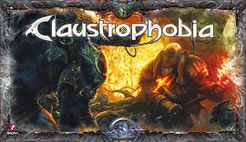
Designer: Croc
Artists: Bertrand Benoit, Aleksi Briclot, Stéphane Gantiez
This game has now fallen to #301. It probably got too tight up here in the Top 300.
This is a game that I’ve never really heard of.
It is a 2-player game that apparently takes up to 45 minutes to play, but it has miniatures and lots of other cool stuff.
Hell, let’s blurb this! (since I’m kind of drunk while writing this and, as I said, I’ve never heard of this game).
“One player controls a small group of determined humans, while the other plays an almost unending army of demonic creatures. The game is thematic and highly asymmetric: human characters are stronger, but the demon characters are more numerous. Gameplay is very straightforward with a minimum of rules, and each game plays in an hour or less.
Basically, dice are allocated after rolling to perform actions, while cards or special abilities are also available. The game is about managing decisions and choosing what to do with the resources that you have, managing difficult events and out-thinking your opponent. Combat is handled by dice.”
The game has a bunch of scenarios (so apparently no campaign) that don’t take up too much time. The Humans are trying to accomplish some task while the demons are trying to stop them.
Does it sound cool?
Kind of.
Will I ever get to play it considering it came out in 2009?
Probably not.
Am I overusing the “asking myself a question in order to answer it in the post” mechanic?
Very probably.
Ok, next!
#298 – For Sale (Eagle-Gryphon Games) – 1997

Designer: Stefan Dorra
Artists: Lots!
This one has fallen to #300, which is probably a product of me downloading this list of games almost 2 months before writing the post.
For Sale is a very quick card game where players are buying and selling real estate (i.e. cards, but we’ll go with it).
The game has two phases.
During the first, players are buying real estate (i.e. cards) to later try to sell at an enormous profit.
During the second phase, you will be selling the real estate that you bought in an attempt to amass the greatest fortune out of all the players (i.e. cards…did I say that before?)
I haven’t played this game since 2016 and I have no real recollection of it, other than it was a fun filler and I’d happily play it again if somebody, you know, brought it to a game day (once we can actually go to a game day again…and I sound like a broken record, don’t I?)
I played this before I kept track of time played per game, but I’m pretty sure this was like a 20-30 minute game at best.
Perfect for lunch or before/after the long slog of a regular game day!
Sadly, even the blurb on BGG isn’t that useful to give a description of the game, but apparently it’s fun!
I do remember enjoying my play of it.
#297 – Bruxelles 1893 (Pearl Games) – 2013
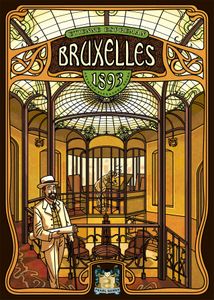
Designer: Etienne Espreman
Artist: Alexandre Roche
This one has fallen to #299. I’m sure it’s some European thing.
Bruxelles 1893 is a game I’ve heard a lot of people say they like but I’ve never really seen anything about how it plays. I’ve always been a bit intrigued, but it’s not something that’s really come out at a game day or anything.
Players in the game are architects in the late 19th century that are trying to produce some awesome architectural thing (can you tell my brother was an architect major in college?) that will give them lots of prestige.
And really, in most of these games, isn’t it about prestige?
It’s a worker placement game with some bidding and area control items as well.
Let’s blurb this from a BGG entry that’s actually useful!
“The action board is modular, with not every player having access to each action each turn. Some actions cost money – acquiring high-quality materials, building a level of your personal house, finding a patron, creating a work of art, selling that art for money and prestige – while other actions are free but can potentially cause you to lose one of your workers; these latter actions include acquiring low-quality materials, activating your patrons, visiting the stock exchange, and taking one of the actions with a cost. Once everyone has passed on taking more actions, the round ends and players have an art exhibition during which they can sell works. After this, players receive prestige points or bonus cards based on the symbols they’ve placed their workers next to on the action board.
After five rounds, the game ends and players score bonus points based on their architect level, their bonus cards, how well they’ve completed their work, and their money on hand. The player with the most points wins.”
It sounds intriguing!
Or it sounds like a Euro game.
Take your pick.
Either way, I’d love to try this and see what others like about the game.
I really should stop doing these posts or I won’t be playing any old favourites at future conventions.
#296 – The Pillars of the Earth (KOSMOS) – 2006
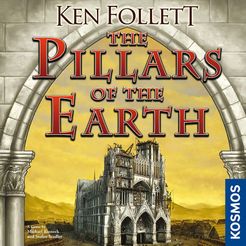
Designers: Michael Rieneck, Stefan Stadler
Artists: Michael Menzel, Anke Pohl, Thilo Rick
This one has fallen to #298. Probably construction delays.
Another worker placement game!
This is one that’s been out of print for a long time, but I think it has a new edition (though from looking at the BGG forum, this was in 2017 so maybe it’s out of print again?).
A lot of people call this a classic worker placement game.
I wouldn’t know because to me it’s just a legend, like Paul Bunyan or me being in perfect mental health.
Let’s blurb it so we can move on.
“At the beginning of the 13th century, construction of the greatest and most beautiful cathedral in England begins. Players are builders who try to contribute the most to this cathedral’s construction and, in so doing, score the most victory points. Gameplay roughly consists of using workers to produce raw materials, and then using craftsmen to convert the materials into victory points. Workers may also be used to produce gold, the currency of the game. Players are also given three master builders each turn, each of which can do a variety of tasks, including recruiting more workers, buying or selling goods, or just obtaining victory points. Getting early choices with a master builder costs gold, as does purchasing better craftsmen. Players must strike a balance between earning gold to fund their purchases and earning victory points.”
It’s based on a book that I’ve also never read (I’ve only read Follett’s World War II books, but those are awesome).
It sounds intriguing, but has anybody played this and can you tell me if it’s worth tracking down?
#295 – In the Year of the Dragon (Rio Grande Games) – 2007

Designer: Stefan Feld
Artists: Harald Lieske, Michael Menzel
This has fallen to #296. Probably disaster fatigue.
A game I’ve kind of played!
Well, once on Boardgame Arena and I didn’t get it.
I think this is one I would need to play in front of me.
Apparently there are disasters, and you have to try and mitigate them as best you can as you try to accumulate victory points.
Or something. It’s Feld, so shouldn’t it be point salad?
Or maybe not?
Let’s blurb and find out.
“Players take on the role of Chinese rulers around the year 1000. The game plays out in twelve rounds, with each round representing one month in a year that seems to go from bad to worse. Disease, drought, and attacks from the Mongols may claim lives, but make sure you have enough money to offer a tribute to the Emperor.
The game play is easier than it may appear. Every player has a set of “person” cards. Each round, you choose one action (most of which call on your workers’ abilities) to help you prepare for the months ahead. Then you play one person card, recruiting that person and placing him into one of your palaces. Each person brings different skills and abilities to help you ride out the year. (Farmers help you gain rice to survive a drought month, Tax Collectors raise money, etc.) At the end of each round, that month’s event is triggered, which may cost you some of your workers, some money, or give you points.”
Now that does sound intriguing!
I’d like to play this on the table once and see if it can actually make sense to me.
Droughts, natural disasters, disease, and attacks on your kingdom.
What’s not to like?
I see you Feld haters in the back!
You can just walk on out of here.
No, I’m kidding…please keep reading.
Wait, you’ve been here, so I’ve already got your hit. Ok, see you!
No, I’m kidding…please come back.
Ahem…ok, next!
#294 – At the Gates of Loyang (Tasty Minstrel Games) – 2009

Designer: Uwe Rosenberg
Artists: Klemens Franz, Scott Hartman
This one has fallen to #297. Probably some dissatisfied customer.
A game I’ve actually played on the table! That makes two now.
I played this for the first (and only) time at OrcaCon 2020. It was quite the experience (check out that post for more on that).
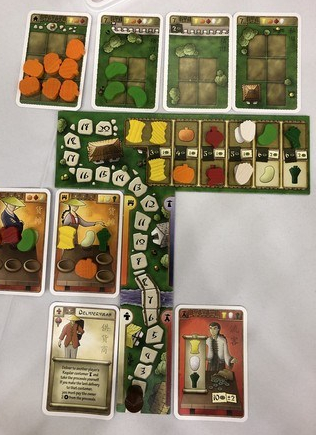
It’s nice that you’re not having to worry about feeding your people, like in a normal Rosenberg game.
Instead, you’re trying to satisfy customers!
You’re going to be growing food, but you are trying to sell the food instead of actually feeding yourself. The game has some nice drafting elements in addition to the “growing food” bit that I really liked. You’re trying to get money each round so that you can pay to move forward on the “Path of Prosperity” which is your point level.
Whoever advances the furthest at the end of the game wins.
I did really enjoy my play of this, though it was marred by substandard players (as mentioned in my post I linked to above)
I’d like to try it again in a better setting and see if I like it more.
I like Rosenberg games where I don’t worry about feeding my family!
I’m not very good at that (ask my wife).
#293 – Endeavor (Z-Man Games) – 2009
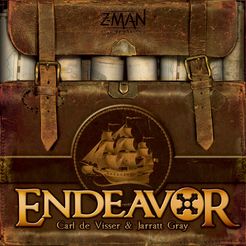
Designers: Carl de Visser, Jarratt Gray
Artists: Josh Cappel, Klemens Franz, Hanno Girke
This one has fallen to #295. Too many headwinds, maybe?
Another game I’ve played!
I’ve played it twice, but both were in 2014 and I don’t really remember much about it.
I do know that they’ve recently had a Kickstarter for a brand new version that looked kind of cool. Not cool enough for me to get it, since I didn’t think I could get it played.
It is a very cool game, though, about the age of exploration from Europe out into the undiscovered lands (unless you happened to be living there, of course).
Let’s blurb this since it’s been 6 years since the last play of it.
“The goal in Endeavor is to earn the most glory for your empire. Players earn glory by increasing their scores in Industry, Culture, Finance, and Politics, as well as by occupying cities, controlling connections between cities, and by holding certain Asset Cards and Building Tiles. Short-term goals of constructing useful buildings, gathering Trade Tokens, and obtaining Asset Cards must be balanced with the overall goal of attaining glory as you compete for control over the various regions of the world. The game only lasts seven rounds, and when it is over you want to be the one who has earned the most Glory points!”
I do recall that it has a Slavery card in it that sort of makes sense and I thought was pretty fairly represented. You can get the immediate benefits of the increased forced labour, but you take a really big hit in the broader scope of the game because of the immorality of it.
As a game mechanism, you have to weigh the pros and cons.
However, as a thinking person from the 21st century, you really have to wonder whether you want to do this or not?
The game seems to really reflect the trade-offs that were there at the time (we’re talking 16th-17th century here) and even as you’re playing it, you have to wonder if you are doing the right thing.
Maybe you go ahead and do it? It’s almost the same as playing a terrorist event in Colonial Twilight. The game makes you really examine the issue. Even if you do end up playing it, you are consciously thinking about why.
I’d like to play this one again to see if my memories of it are accurate or not.
#292 – 51st State: Master Set (Portal Games) – 2016

Designer: Ignacy Trzewiczek
Artist: Grzegorz Bobrowski
Another fall, this one to #294. Must be the mutants.
Another game I’ve played! Wow, we’re on a roll.
I’ve only played it once, but I really did enjoy my play of it.
It definitely has that Imperial Settlers feel, though it’s interesting that this Master set was done after Imperial Settlers but the original version was done before.
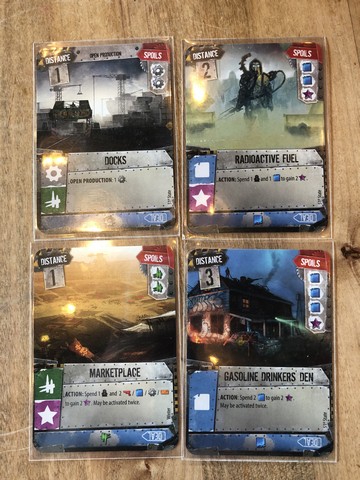
The game is a card game where you are trying to develop your post-apocalyptic country to a better extent than your opponents are doing theirs.
You can build a building and place it in your city if you have the resources. Or you can raze it to get a one-time boost. Or perhaps you want to trade with it? That will get you some resources too.

I really enjoyed my first plays of Imperial Settlers but when I first played this one in April 2019, I knew that I would much rather play this one than that.
I loved the mechanisms where you either have a building that produces stuff, a building that you can use each turn, or perhaps a building you can use to chain actions and resources together with.
And I really liked that you built your own city rather than also having your own stuff like in Imperial Settlers. For some reason that really appealed to me.
Of course I sucked at the game. But I’d love to play it some more and see if I can improve.
And the card artwork is great!

It really gives you that apocalyptic yet everything’s pretty cool feel to it.
I’d definitely be up for playing more of this one. Abi, will you bring it to our next game day? You know, in 2022? *sigh*
#291 – San Juan (Ravensburger) – 2004
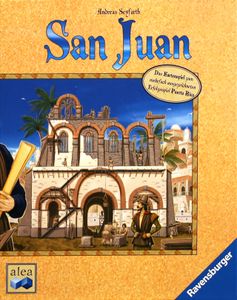
Designer: Andreas Seyfarth
Artist: Franz Vohwinkel
Another one that I’ve not only played, but I own. It’s a classic game and one of my early buys (after bouncing off of Race for the Galaxy because of the iconography).
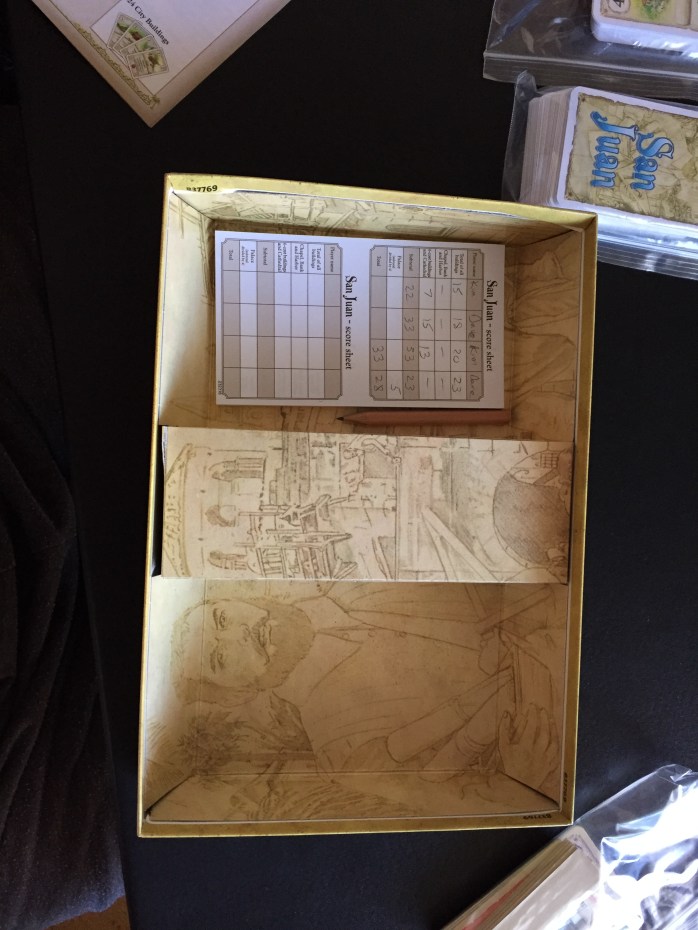
I have to question the insert, though.
That being said, it’s a great card game based on the classic Puerto Rico, but in a much more compact form.
I even did a review of it! (So I don’t have to actually go into how it plays).
I really do like this one and I should get it back to the table sometime soon.
It plays very similarly to Race for the Galaxy but it doesn’t have the same issue of the nearly impenetrable icons that are hard to understand until you’ve played it a few times (having played the app many times, I am one of those people, but I certainly wasn’t when I bought San Juan).
I like how you’re using cards both as buildings that you want to put in your tableau as well as money to pay for those buildings.
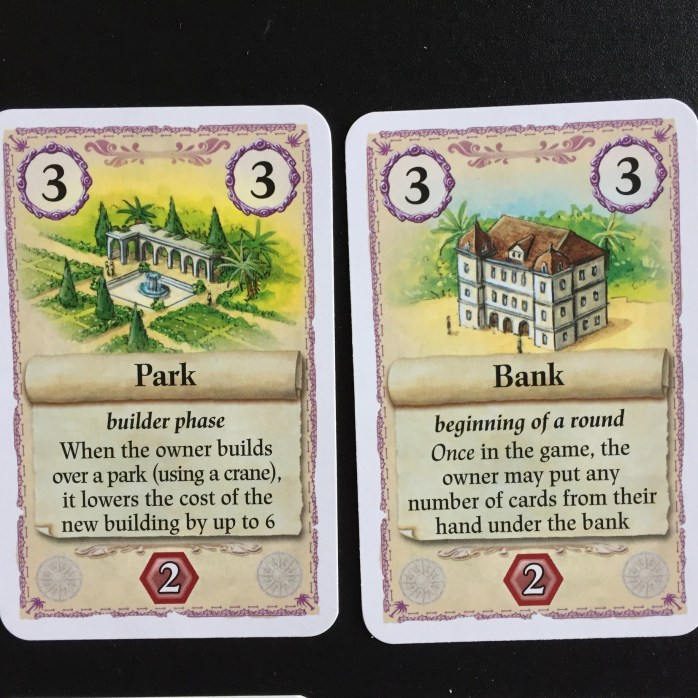
The push and pull decisions in this are really intriguing.
When you finish your tableau before everybody else, it’s a great feeling.
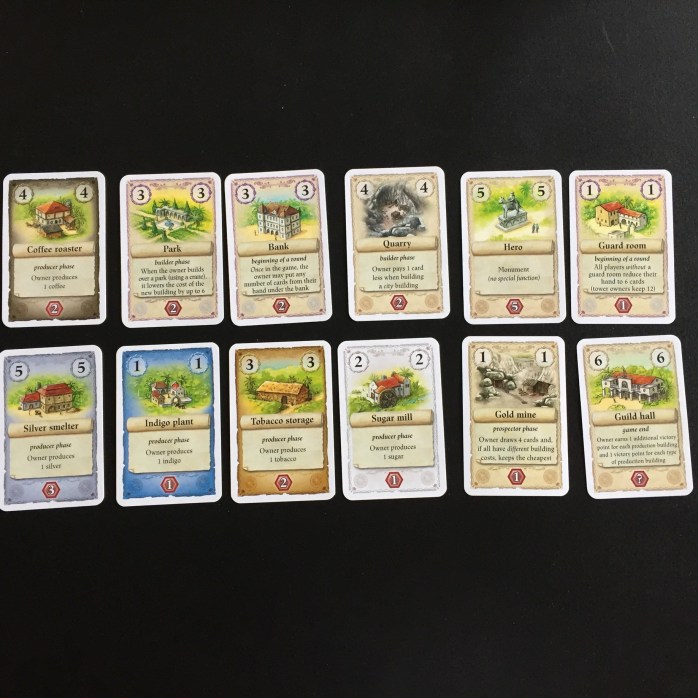
I really need to get this one played again. Maybe with the wife since we’re still in COVID lockdown?
And there we go.
A month or so late, but the first in the series talking about #300-201 on BGG.
What do you think of these games? Any that you hate? Any that you love?
Any that you would bring with you into your post-apocalyptic state, maybe as your executive assistant?
Let me know in the comments (especially if you’re willing to play them with me at the next convention).
Posts in this Series
#300-291
#290-281
#280-271
#270-261
#260-251
#250-241
#240-231
#230-221
#220-211
#210-201
3/10 for me – thought it will be worse. I played:
– For Sale – really fun to play card game, with element of gambling and two-levels of betting; I really like it
– The Pillars of the Earth – game based on fantastic book (which I can wholeheartedly recommend). The itself is also good, a worker placement with a twist.
– 51st State – how could I not play Portal Games (Polish publisher) games from the Neuroshima Hex universe? Really interesting card game, which is not so obvious in its mechanics.
LikeLiked by 1 person
I will have to check out the book one of these days. I wouldn’t mind trying the game out one time. As I get further and further down the list we might see some wargames! 🙂
LikeLiked by 1 person
San Juan is a pretty elegant design. It’s one of the few games I saved from my teenage collection (although I haven’t played it a lot).
LikeLiked by 1 person
I haven’t played it in ages, but it is fun. I would definitely play it again.
LikeLiked by 1 person
Pingback: Boardgame Geek Top 300 – Play or Played – #290-281 – Dude! Take Your Turn!
Pingback: Boardgame Geek Top 300 – Play or Played – #280 – 271 – Dude! Take Your Turn!
Pingback: Boardgame Geek Top 300 – Play or Played – #270-261 – Dude! Take Your Turn!
Pingback: Boardgame Geek Top 300 – Play or Played – #260-251 – Dude! Take Your Turn!
Pingback: Boardgame Geek Top 300 – Play or Played – #250 – 241 – Dude! Take Your Turn!
Pingback: Boardgame Geek Top 300 – Play or Played – #240 – 231 – Dude! Take Your Turn!
Pingback: Boardgame Geek Top 300 – Play or Played – #230-221 – Dude! Take Your Turn!
Pingback: Boardgame Geek Top 300 – Play or Played – #220-211 – Dude! Take Your Turn!
Pingback: Boardgame Geek Top 300 – Play or Played – #210-201 – Dude! Take Your Turn!